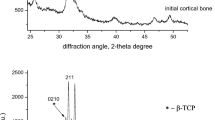Abstract
Bones of experimental rats fed a high strontium diet (0.4% Sr, 0.2% Ca, 0.4% P) and those of control rats fed a diet essentially the same but without supplemental strontium (0.4% Ca, 0.4% P) were analyzed for certain organic and mineral constituents. The femora of experimental animals had a significantly greater proportion of hexosamine as cetyl pyridinium precipitable material (glycosaminoglycans) than did those of control animals, whereas no difference of hydroxyproline (collagen) content was found. Separation of powdered, pooled bones by the flotation method revealed that over 80% of normal bone and only about 50% of experimental bone had a specific gravity of 1.87 or greater. The incorporation of strontium was accompanied by a marked reduction of bone ash, by elevated magnesium and potassium, and by depressed calcium contents of the ash as compared to normal bone.
Résumé
Les os de rats soumis à une alimentation riche en strontium (0.4% Sr, 0.2% Ca, 0.4% P) et ceux de rats témoins, alimentés de la même façon, sans adjonction de strontium (0.4% Ca, 0.4% P), ont été analysés pour certains constituants organiques et inorganiques. Le fémur des animaux, soumis au strontium, contient une proportion significativement plus élevée d’hexosamine sous la forme d’un matériel précipitable par le cetyl pyridinium (glycosaminoglycanes); cependant aucune différence en hydroxyleproline (collagène) n’a été notée. Le fractionnement de poudres d’os par la méthode de flotation montre que plus de 80% de l’os normal et seulement 50% de l’os des animaux soumis au strontium ont un poids spécifique de 1.87 ou supérieur. L’incorporation du strontium s’accompagne d’une part, d’une diminution marquée de la cendre d’os, par suite de l’augmentation du magnésium et potassium, et d’autre part, de la diminution du contenu en calcium de la cendre par rapport à l’os normal.
Zusammenfassung
Die Knochen von Versuchsratten, welche eine hohe Strontium-Diät erhielten (0,4% Sr; 0,2% Ca; 0,4% P) und die Knochen von Kontrollratten, welche praktisch dieselbe Diät ohne zusätzliches Strontium erhielten (0,4% Ca; 0,4% P), wurden auf bestimmte organische und Mineralbestandteile untersucht. Die Femora der Versuchstiere enthielten einen bedeutend größeren Anteil an Hexosamin, das mit Cetylpyridin (Glycosaminoglycanen) ausgefällt werden kann, als die jenigen der Kontrolltiere, jedoch wurde beim Hydroxyprolingehalt (Collagen) kein Unterschied gefunden. Die Trennung von pulverisierten, gepoolten Knochen durch die Dichtegradientmethode zeigte, daß über 80% des normalen Knochens und nur etwa 50% des experimentellen Knochens ein spezifisches Gewicht von 1,87 und mehr aufwiesen. Die Einnahme von Strontium verursachte eine bedeutende Abnahme der Knochenasche, eine Zunahme von Magnesium und Kalium und einen verminderten Calciumgehalt in der Asche im Vergleich zu normalen Knochen.
Similar content being viewed by others
References
Analytical methods for atomic absorption spectrophotometry. Revised edition, Norwalk, Connecticut: Perkin-Elmer Corp. 1968.
Brown, W. E.: Crystal growth of bone mineral. Clin. Orthop.44, 205–220 (1966).
Campo, R. D., Tourtellotte, C. D.: The composition of bovine cartilage and bone. Biochim. biophys. Acta (Amst.)141, 614–624 (1967).
Collin, R. L.: Precipitate formation in the strontium-phosphate system. Science151, 1386–1388 (1966).
Fiske, C. H., Subba Row, Y.: Determination of phosphorus. J. biol. Chem.66, 375–400 (1925).
Francis, M. D., Webb, N. C.: Hydroxyapatite formation from a hydrated calcium monohydrogen phosphate precursor. Calc. Tiss. Res.6, 335–342 (1971).
Herring, G. M.: The chemical structure of tendon cartilage, dentin and bone matrix. Clin. Orthop.60, 261–299 (1968).
Hjertquist, S.-O., Vejlens, L.: The glycosaminoglycans of dog compact bone and epiphyseal cartilage in the normal state and in experimental hyperparathyroidism. Calc. Tiss. Res.2, 314–333 (1968).
Johnson, A. R.: Improved method of hexosamine determination. Analyt. Biochem.44, 628–635 (1971).
Johnson, A. R., Armstrong, W. D., Singer, L.: The incorporation and removal of large amounts of strontium by physiologic mechanisms in mineralized tissues of the rat. Calc. Tiss. Res.,2, 242–252 (1968).
Johnson, A. R., Armstrong, W. D., Singer, L.: The solubility of the mineral phase in the rat of powdered bone and dentin laden with strontium. Arch. oral Biol.15, 401–409 (1970).
Johnson, A. R., Armstrong, W. D., Singer, L.: The exchangeability of calcium and strontium of bonein vitro. Calc. Tiss. Res.6, 103–112 (1970).
Kinney, E. M., McCollum, E. V.: A study of the rate of deposition and paths of absorption of strontium in the rat. J. Pharmacol. exp. Ther.21, 165–176 (1923).
Neuman, W. F., Toribara, T. Y., Mulryan, B. J.: Synthetic hydroxyapatite crystals. I. Sodium and potassium fixation. Arch. Biochem. Biophys.98, 384–390 (1962).
Neuman, W. F., Bjornerstedt, R., Mulryan, B. J.: Synthetic hydroxyapatite crystals. II. Aging and strontium incorporation. Arch. Biochem. Biophys.101, 215–224 (1963).
Newesely, H., Höhling, H.-J.: Recent findings on the crystal structures of hypomineralized and carious teeth. Adv. Fluorine Res. and Dental Caries Prevention3, 131–135 (1964).
Prokop, D. J., Udenfriend, S.: A specific method for the analysis of hydroxyproline in tissues and urine. Analyt. Biochem.1, 228–239 (1960).
Robinson, R. A.: Chemical analysis and electron microscopy of bone. In: Bone as a tissue, edit. by Rodahl, K., Nicholson, J. T., and Brown, E. M., Jr., p. 186–250, New York: McGraw-Hill Book Company, Inc. 1960.
Scott, J. E.: Aliphatic ammonium salts in the assay of acidic polysaccharides from tissues. In: Methods of biochemical analysis, vol. 8, p. 145–197, edit. by Glick, D. New York: John Wiley & Sons. 1960.
Storey, E. Strontium “rickets”: bone, calcium and strontium changes. Aust. Ann. Med.10, 213–222 (1961).
Storey, E., West, V. C.: Factors modifying Ca/Sr discrimination by bone and synthetic “apatitic” mineralin vitro. Calc. Tiss. Res.6, 290–300 (1971).
Termine, J. D., Wuthier, R. E., Posner, A. S.: Amorphous-crystalline mineral changes during endochondral and periosteal bone formation. Proc. Soc. exp. Biol. (N.Y.)125, 4–9 (1967).
Triffitt, J. T., Sutton, A.: Strontium and calcium contents of bone density fractions. Calc. Tiss. Res.4, 174–179 (1969).
Zipkin, I.: The inorganic composition of bones and teeth. In: Biological calcification, edit. by Schraer, H., p. 69–103. New York: Appleton-Century-Crofts Educational Division/Meredith Corporation 1970.
Author information
Authors and Affiliations
Additional information
Department of Pediatrics, School of Medicine
Rights and permissions
About this article
Cite this article
Johnson, A.R. The influence of strontium on characteristic factors of bone. Calc. Tis Res. 11, 215–221 (1973). https://doi.org/10.1007/BF02547220
Received:
Accepted:
Issue Date:
DOI: https://doi.org/10.1007/BF02547220



